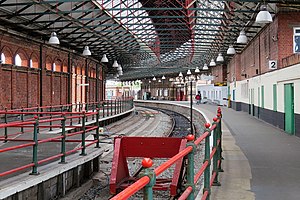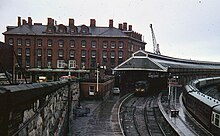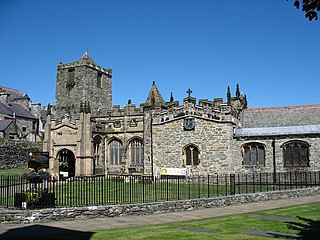
Holyhead is the largest town and a community in the county of Isle of Anglesey, Wales, with a population of 13,659 at the 2011 census.. Holyhead is on Holy Island, bounded by the Irish Sea to the north, and is separated from Anglesey island by the narrow Cymyran Strait and was originally connected to Anglesey via the Four Mile Bridge.

Birmingham International is a railway station known by code "BHI" in the Metropolitan Borough of Solihull in the West Midlands of England, just east of Birmingham. It is on the Rugby–Birmingham–Stafford line 14 km (8.7 mi) east of Birmingham New Street railway station. BHI serves Birmingham Airport, the National Exhibition Centre, the Resorts World Arena, and Resorts World Birmingham.

Arriva Trains Wales was a British train operating company owned by Arriva UK Trains that operated the Wales & Borders franchise. It ran urban and inter-urban passenger services to all railway stations in Wales, including Cardiff Central, Cardiff Queen Street, Newport, Swansea, Wrexham General and Holyhead, as well as to certain stations in England such as Hereford, Shrewsbury, Chester, Crewe, Manchester Piccadilly and Birmingham New Street.

Crewe railway station serves the railway town of Crewe, in Cheshire, England. It opened in 1837 and is one of the most historically significant railway stations in the world.

The North Wales Main Line, also known as the North Wales Coast Line, is a major railway line in the north of Wales and Cheshire, England, running from Crewe on the West Coast Main Line to Holyhead on the Isle of Anglesey. The line has 19 stations, with all except two, Chester and Crewe, being in Wales.

The Welsh Marches line, known historically as the North and West Route, is the railway line running from Newport in south-east Wales to Shrewsbury in the West Midlands region of England by way of Abergavenny, Hereford and Craven Arms and thence to Crewe via Whitchurch. The line thus links the south of Wales to north-west England via the Welsh Marches region, bypassing Birmingham. Through services from south-west Wales, Swansea and Cardiff to Manchester and from Cardiff to Wrexham, Chester, the north coast of Wales and Anglesey constitute the bulk of passenger operations on the route.

Bangor railway station serves the city of Bangor, Gwynedd; it is operated by Transport for Wales. The station, which is 24+3⁄4 miles (40 km) east of Holyhead, is the last mainland station on the North Wales Coast line between Crewe and Holyhead. It is the busiest in terms of passenger numbers in North Wales, as it serves the community around Caernarfon and further west. It is close to the Snowdonia National Park and Bangor University, and has an interchange with bus services to the various towns and villages of north-west Gwynedd and Anglesey.

Tamworth is a split-level railway station which serves the market town of Tamworth in Staffordshire, England. It is an interchange between two main lines; the Cross Country Route and the Trent Valley section of the West Coast Main Line (WCML). It has four platforms: Two low-level platforms on the WCML, and, at a right-angle to, and passing over these, are two high-level platforms served by the Cross Country Route. Historically there were chords connecting the two lines, but there is no longer any rail connection between them.

Shrewsbury railway station is in Shrewsbury, Shropshire, England. Built in 1848, it was designated a grade II listed building in 1969.

Llandudno Junction is a station serving the village of Llandudno Junction on the North Wales Main Line between Crewe and Holyhead. The station is managed by Transport for Wales Rail, although Avanti West Coast services also stop there. It is a junction for trains to Llandudno and the Conwy Valley line.

Stafford railway station is a major interchange railway station in Stafford, Staffordshire, England, and is the second busiest railway station in Staffordshire, after Stoke-on-Trent. The station serves the market and county town, as well as surrounding villages. The station lies on the junction of the Trent Valley line, the Birmingham Loop/Rugby–Birmingham–Stafford line, and the West Coast Main Line.

Chester railway station is located in Newtown, Chester, England. Services are operated by Avanti West Coast, Merseyrail, Northern and Transport for Wales. From 1875 to 1969, the station was known as Chester General to distinguish it from Chester Northgate. The station's Italianate frontage was designed by the architect Francis Thompson.
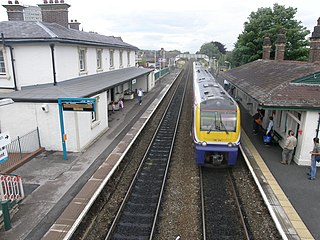
Flint railway station serves the town of Flint in Flintshire, North Wales. It is located on the North Wales Coast Line and is managed by Transport for Wales, who provide most of the passenger trains that call here. There are certain Avanti West Coast services that serve the station.
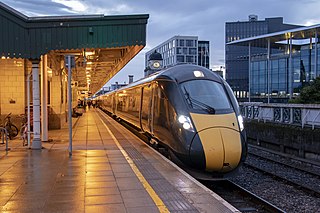
Transport in Wales is heavily influenced by the country's geography. Wales is predominantly hilly or mountainous, and the main settlements lie on the coasts of north and south Wales, while mid Wales and west Wales are lightly populated. The main transport corridors are east–west routes, many continuing eastwards into England.

Llandudno railway station serves the seaside town of Llandudno in North Wales. It is the terminus of a 3 miles (4.8 km) long branch line from Llandudno Junction on the North Wales Coast Line, between Crewe and Holyhead. The station is managed by Transport for Wales Rail, who operate all trains serving it. Llandudno Victoria station, the lower terminus of the Great Orme Tramway, is a 15-minute walk from the main station.
Colwyn Bay railway station is on the Crewe to Holyhead North Wales Coast Line serving the seaside town of Colwyn Bay in North Wales.

Rhyl railway station is on the Crewe to Holyhead North Wales Coast Line and serves the holiday resort of Rhyl, Wales.

Prestatyn railway station on the North Wales Coast Line serves the town of Prestatyn in North Wales.
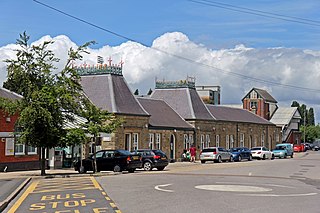
Wrexham General is the main railway station serving the city of Wrexham, north-east Wales, and one of the two serving the city, alongside Wrexham Central. It is currently operated and mostly served by Transport for Wales, with some additional services provided by Avanti West Coast to London Euston.

The Port of Holyhead is a commercial and ferry port in Anglesey, United Kingdom, handling more than 2 million passengers each year. It covers an area of 240 hectares, and is operated by Stena Line Ports Ltd. The port is the principal link for crossings from north Wales and central and northern England to Ireland. The port is partly on Holy Island and partly on Salt Island. It is made up of the Inner Harbour, the Outer Harbour and the New Harbour, all sheltered by the Holyhead Breakwater which, at 2.7 kilometres, is the longest in the UK.
